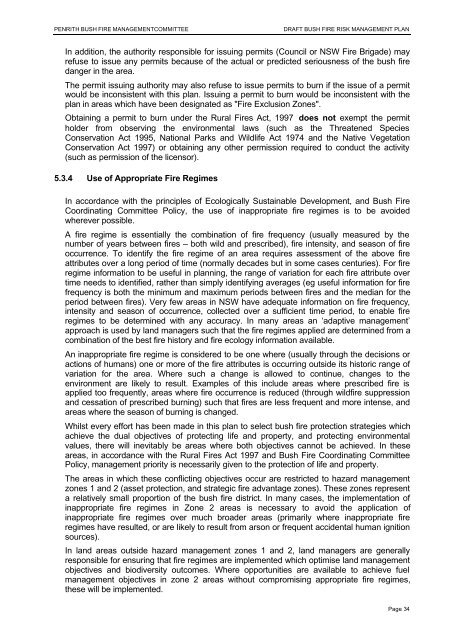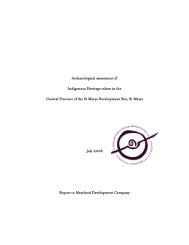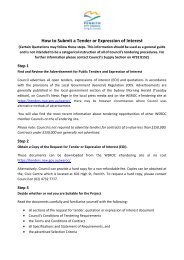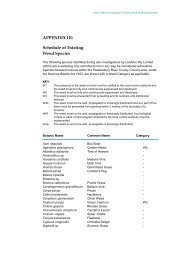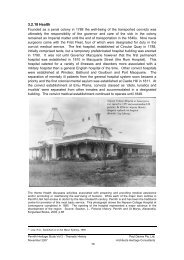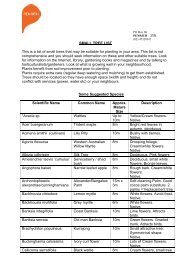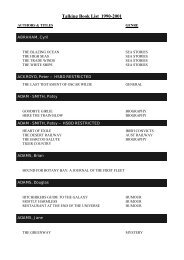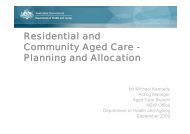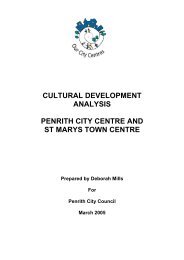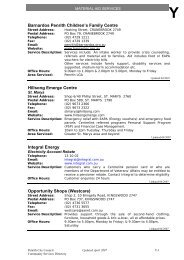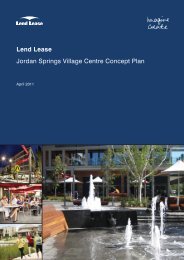Penrith Bush Fire Management Committee Bush Fire Risk ...
Penrith Bush Fire Management Committee Bush Fire Risk ...
Penrith Bush Fire Management Committee Bush Fire Risk ...
You also want an ePaper? Increase the reach of your titles
YUMPU automatically turns print PDFs into web optimized ePapers that Google loves.
PENRITH BUSH FIRE MANAGEMENTCOMMITTEE DRAFT BUSH FIRE RISK MANAGEMENT PLAN<br />
In addition, the authority responsible for issuing permits (Council or NSW <strong>Fire</strong> Brigade) may<br />
refuse to issue any permits because of the actual or predicted seriousness of the bush fire<br />
danger in the area.<br />
The permit issuing authority may also refuse to issue permits to burn if the issue of a permit<br />
would be inconsistent with this plan. Issuing a permit to burn would be inconsistent with the<br />
plan in areas which have been designated as "<strong>Fire</strong> Exclusion Zones".<br />
Obtaining a permit to burn under the Rural <strong>Fire</strong>s Act, 1997 does not exempt the permit<br />
holder from observing the environmental laws (such as the Threatened Species<br />
Conservation Act 1995, National Parks and Wildlife Act 1974 and the Native Vegetation<br />
Conservation Act 1997) or obtaining any other permission required to conduct the activity<br />
(such as permission of the licensor).<br />
5.3.4 Use of Appropriate <strong>Fire</strong> Regimes<br />
In accordance with the principles of Ecologically Sustainable Development, and <strong>Bush</strong> <strong>Fire</strong><br />
Coordinating <strong>Committee</strong> Policy, the use of inappropriate fire regimes is to be avoided<br />
wherever possible.<br />
A fire regime is essentially the combination of fire frequency (usually measured by the<br />
number of years between fires – both wild and prescribed), fire intensity, and season of fire<br />
occurrence. To identify the fire regime of an area requires assessment of the above fire<br />
attributes over a long period of time (normally decades but in some cases centuries). For fire<br />
regime information to be useful in planning, the range of variation for each fire attribute over<br />
time needs to identified, rather than simply identifying averages (eg useful information for fire<br />
frequency is both the minimum and maximum periods between fires and the median for the<br />
period between fires). Very few areas in NSW have adequate information on fire frequency,<br />
intensity and season of occurrence, collected over a sufficient time period, to enable fire<br />
regimes to be determined with any accuracy. In many areas an ‘adaptive management’<br />
approach is used by land managers such that the fire regimes applied are determined from a<br />
combination of the best fire history and fire ecology information available.<br />
An inappropriate fire regime is considered to be one where (usually through the decisions or<br />
actions of humans) one or more of the fire attributes is occurring outside its historic range of<br />
variation for the area. Where such a change is allowed to continue, changes to the<br />
environment are likely to result. Examples of this include areas where prescribed fire is<br />
applied too frequently, areas where fire occurrence is reduced (through wildfire suppression<br />
and cessation of prescribed burning) such that fires are less frequent and more intense, and<br />
areas where the season of burning is changed.<br />
Whilst every effort has been made in this plan to select bush fire protection strategies which<br />
achieve the dual objectives of protecting life and property, and protecting environmental<br />
values, there will inevitably be areas where both objectives cannot be achieved. In these<br />
areas, in accordance with the Rural <strong>Fire</strong>s Act 1997 and <strong>Bush</strong> <strong>Fire</strong> Coordinating <strong>Committee</strong><br />
Policy, management priority is necessarily given to the protection of life and property.<br />
The areas in which these conflicting objectives occur are restricted to hazard management<br />
zones 1 and 2 (asset protection, and strategic fire advantage zones). These zones represent<br />
a relatively small proportion of the bush fire district. In many cases, the implementation of<br />
inappropriate fire regimes in Zone 2 areas is necessary to avoid the application of<br />
inappropriate fire regimes over much broader areas (primarily where inappropriate fire<br />
regimes have resulted, or are likely to result from arson or frequent accidental human ignition<br />
sources).<br />
In land areas outside hazard management zones 1 and 2, land managers are generally<br />
responsible for ensuring that fire regimes are implemented which optimise land management<br />
objectives and biodiversity outcomes. Where opportunities are available to achieve fuel<br />
management objectives in zone 2 areas without compromising appropriate fire regimes,<br />
these will be implemented.<br />
Page 34


